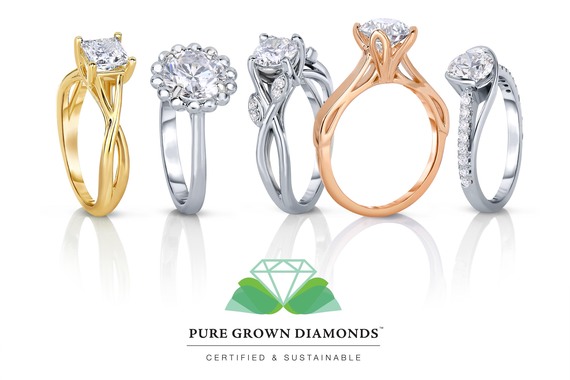As a lover of jewelry, I've always found anything that sparkles alluring, and diamonds have always had a particular appeal. So, you can just imagine how exciting it was to interview the Director of Pure Grown Diamonds, Suraj Mehta, to learn more about cultured diamonds and how they are taking the diamond industry by storm.
Modern technology has come a long way and actually made it possible to replicate the exact conditions needed to grow diamond crystals in a laboratory. Pure Grown Diamond places a small diamond seed into a tightly controlled environment, where the diamond grows and is able to recreate the natural process above ground; the results are absolutely stunning!
Millennials are currently some of the biggest fans of these pure grown diamonds, with a significant percentage saying they would totally consider buying a cultured diamond as a center stone for their engagement ring. Not only are these lab grown diamonds economically more affordable [30% cheaper than mined diamonds], but they're also the go to choice for the environmentally and socially conscious jewelry connoisseur. Perhaps this is why Pure Grown Diamonds was trending on Hollywood's red carpet this year. Here's more from my enlightening conversation with the Director of Pure Grown Diamonds, Siraj Mehta.
What is a synthetic diamond and how long have these kinds of diamonds been around for?
Let me start by saying that the term "synthetic" is not a term we consider fitting when describing Pure Grown Diamonds, as people often associate this word with "fake" or "inauthentic." We feel that terms such as "cultured," and "lab-grown" are more suitable descriptors. The most accurate though is "Pure Grown Diamond".
A Pure Grown Diamond is a genuine diamond with a different point of origin. Instead of coming from a mine, a Pure Grown Diamond is grown through a proprietary process that has unlocked nature's secret recipe for growing diamonds.
This process is akin to growing exotic flowers in a greenhouse: We create the necessary conditions to grow a diamond atom-by-atom from a carbon seed, and the result is a diamond that is cut, polished, and certified just like a mined diamond. The race to grow diamonds started just over 200 years ago when Antoine Lavoisier discovered that diamonds were made of pure carbon. After a couple of centuries of failed attempts by scientists around the world and a decade of research on the growth side, Pure Grown diamonds, was the first to the consumer with these gorgeous diamonds just over 2 years ago.
How are Pure Grown Diamonds different from natural diamonds?
Pure Grown Diamonds are chemically, physically, and optically identical to mined diamonds. To a consumer as well as a gemologist or a jeweler, the only difference is its point of origin.
Just like a mined diamond, every Pure Grown Diamond is unique. Even though two diamonds might grow together in the same laboratory, they will definitely not be identical. This is because diamonds are grown as a result of a natural crystallization process. The only human intervention is to start the growth, after this nature takes over. They are genuine diamonds with the only difference being their origin.
Would anyone be able to tell the difference between A Pure Grown diamond and the natural diamond with the naked eye?
It is virtually impossible, with the naked eye, to tell the difference between a Pure Grown and a mined diamond, since both are diamonds.
Pure Grown Diamonds, though, can often be recognized by the fact that they are rare Type IIa diamonds. Type IIa diamonds are only 2% of the world's supply, extremely rare and famous for their unmatched brilliance, scintillation and fire. You do however need specialized equipment to find this rare characteristic. Some famous Type IIa diamonds are the famous Koh-i-Noor diamond or the Elizabeth
Taylor diamond (formerly known as the Krupp Diamond).
They could also be recognized by the certificate number that is inscribed on the girdle of every Pure Grown Diamond over 0.30 carat in weight. These certificates are issued by third party, highly reputable labs like the International Gemological Institute (IGI) and Gem Certification & Assurance Lab (GCAL).
Pure Grown diamonds have been referred to as the socially and environmentally conscious diamond, can you tell me more about this?
A Pure Grown Diamond is by far a more sustainable and eco-conscious choice when compared to that of mined diamonds. In an environmental impact assessment report conducted by Frost & Sullivan in 2014, it was determined that that the environmental impact of growing diamonds is seven times lower than diamond mining.
Land Disturbed
Frost & Sullivan report noted that because next to no soil is displaced or disturbed in growing diamonds. The environmental impact on land is Nil compared to mined diamonds where open pit, coastal, and seabed mining is estimated to disturb nearly 1300 times more soil per carat than lab-grown diamonds.
Carbon Emissions
Even more drastic is the difference in carbon, nitrous oxide (NOx) and sulfur oxide (SOx) emissions between lab grown and mined diamonds. According to Frost & Sullivan, mined diamonds emit a staggering 1.5 billion times more carbon, NOx, and SOx per carat production than that of lab-grown diamonds, which result in little to no emissions of significance.
Water Impact
Frost and Sullivan report also notes that there is "no detrimental impact associated with water usage such as the discharge of waste water or pollutants in water bodies" in the production of lab-grown diamonds. Mined diamonds, however, have had a much greater impact on introducing pollutants into water bodies, though the industry has aimed to reduce this over time.
Overall, Pure Grown Diamonds emerge as a more sustainable choice allowing humans and nature to work harmoniously so that resources can be preserved now while ensuring that future generations will be supported.
Whose primarily buying Pure Grown diamonds right now?
Several consumer studies show that demand for lab-grown diamonds has grown significantly in a short period of time. According to a study done by NPD Group Diamond Tracker, which collected sales data from 3,950 specialty retail jewelers in America from January 2015 - January 2016, it was found that sales of lab grown diamonds tripled within a year's time, with 1-carat round diamonds being the most popular selection.
Regarding consumers of lab-grown diamonds, it has been found that millennial audiences in particular have shown a strong, growing interest in the lab-grown diamond category. According to a study conducted by MVI Marketing surveying men and women aged 21-35 years, 55% reported that they would consider buying a lab-grown diamond as the center stone for an engagement ring, with 65% agreeing that they should be referred to as diamonds because they are made of the same chemicals as mined diamonds.
Moreover, nearly half of those surveyed referenced eco-conscious and human rights motives as to why they would choose lab-grown, while 18% said because Pure Grown Diamonds are more affordable than mined diamonds (nearly 30% more affordable).
Like the natural diamond, are there different qualities with the Pure Grown diamond, as well? If so, what should potential buyers look for?
Yes there are different qualities and consumers should look for exactly what they would were they buying any diamond: The 4C's - Cut, Color, Clarity and Carat weight, as defined in a Gemological certificate from well-known independent labs like the International Gemological Institute and the Gem Certification & Assurance Lab (GCAL).
Lab-grown diamonds are subject to the same variables affecting its quality as mined diamonds, as these diamonds are grown in a process that recreates a natural growing environment. Therefore, it is important that buyers consider the diamonds four C's - cut, carat, color, and clarity - when selecting a lab grown diamond, just as they would when choosing a mined diamond. Because of this, it is important to understand that once the conditions are made and the diamond is in the process of growing, we have no control over how the specifications of the diamond when it is finished, so a diamond cannot be grown to fit a customer's specific needs.
Why do you think these cultured diamonds are not given the same status as natural diamonds yet? What do you think would need to shift in order to change this perception around?
We feel that with a reported 55% of consumers already favoring lab-grown diamonds over mined, according to MVI's study, lab grown diamonds have in fact garnered the same status as mined diamonds, and this perception will only grow over time. It is an astounding achievement that in just a few years, lab-grown diamonds have already appealed to more than half of consumers in such a short amount of time. With today's consumers growing more and more socially and environmentally conscious, we feel that Pure Grown Diamonds values of sustainability and eco-consciousness align perfectly with that of the consumer's mindset. This alignment of values has allowed the status of Pure Grown Diamonds to flourish and solidify, and it will continue to do so over time.
Pure Grown Diamond's mission is to continue to provide beautiful, quality diamonds that are affordable and conflict free for their loyal customers. To find out more about Pure Grown Diamonds you can go to their website: www.PureGrownDiamonds.com



